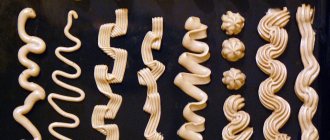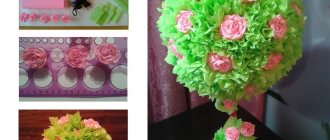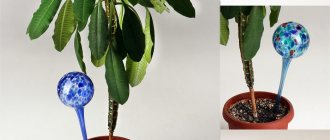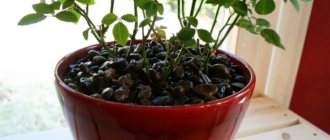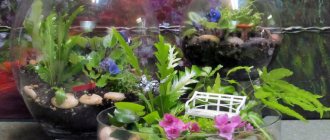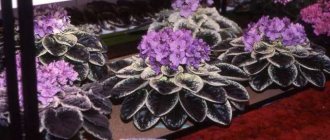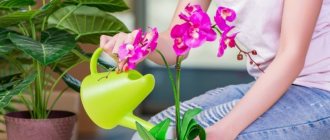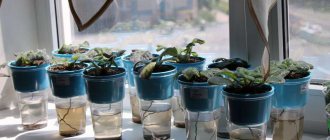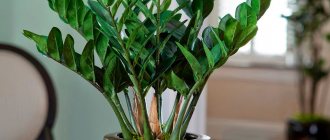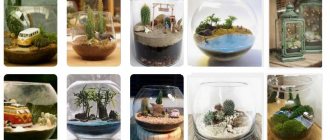Advertising:
Artificial flowers are universal both in terms of materials of manufacture and in terms of application.
What artificial flowers are made from - paper and fabric, plastic and polymer clay, threads and twine, braid and lace, newspapers and autumn leaves - the materials for artificial flowers can be listed for a very long time, as well as the methods of their manufacture and use.
Therefore, in order to save both our and your time, we invite you to immediately familiarize yourself with a selection of the most interesting and simple master classes on making artificial flowers.
Flowers made of satin ribbons and fabric:
Option 1
Materials:
- Wide satin ribbon in cream or pink colors
- Wide green satin ribbon
- Narrow satin ribbon for decoration
- Needle, thread
Option 2
Materials:
- Wide satin ribbon in two shades of the same color (in this case, cream and light brown)
- Buttons
- Needle, thread
Option 3
Materials:
- Wide satin ribbon in cream or pink colors
- Wide gray satin ribbon
- Narrow gray satin ribbon
- Needle, thread
Option 4
Materials:
- Wide white satin ribbon
- Wide yellow satin ribbon
- Wide green satin ribbon
- Needle, thread
Option 5
Materials:
- Wide satin ribbon
- Needle, thread
Option 6
Materials:
- Textile
- Felt
- Flower wire
- Floral Ribbon
- Glue gun
Option 7
Materials:
- Narrow satin ribbon colored
- Thin strip of organza or lace
- Button
Option 8:
Materials:
- White thread
- Green thread
- Balloons
- PVA glue
- Flower wire
- Floral Ribbon
- fine lace
Procedure: cover the table with paper, inflate the balloon, thread the needle straight from the spool and pierce the bottle of glue with the needle. Wrap the ball with a thread soaked in glue in any order. Wait until the glue has completely dried, pierce the ball, and cut the resulting drop of thread.
Option 9:
DIY ribbon with felt flowers
Materials:
- Felt or felt
- Glue
- Elastic tape
Link to a master class on creating a ribbon with felt flowers
Option 10
Wire ribbon peonies
Materials:
- Wire satin ribbon
- Needle, thread
Link to a master class on making peonies from wire tape
Crochet flowers
Crocheted flowers are a beautiful and original decoration. There are a huge number of technologies for creating flowers from yarn. We'll start with the simplest method. So, to create crochet colors you will need the following:
- yarn (it is better to use wool of several colors);
- hook 3.5 mm.
Let's start by knitting the central element using single crochets, of which we should end up with 14 pieces. We fasten the thread. The middle of the flower is ready.
Now let's start creating the first layer of petals. For this we use orange yarn. We knit the petals as shown in the picture.
The result is 7 petals.
Now we make the second layer of petals.
By analogy with the previous one, we create the third layer of petals. There should be 7 loops in the chain.
Next we make a contrasting edging. The result is a bright and beautiful flower that can be used to decorate clothes or a headdress.
Now we are convinced that you can create beautiful artificial flowers yourself. Choose the material you like and go ahead! In this article, we looked at just a few ways to create artificial plants. But there are many more of them. Create, experiment and enjoy the beauty and originality of artificial flowers created by your own hands!
Artificial paper flowers:
Option 1
Materials:
- Corrugated paper in different colors
- Wire
Option 2
Materials:
- Corrugated cups for cupcakes in different colors
- Garland
Option 3
Materials:
- Newspapers or sheets cut from books
- glue
- braid
- wire
Option 4
Materials:
- Thin paper handkerchiefs
- invisible
- floral ribbon
- flower wire
- multi-colored markers
Option 5
Materials:
- Corrugated paper
- wire
Option 6
Materials:
- thick multi-colored paper
- wire
Option 7
Materials:
- multi-colored corrugated paper
- wire
- pins
Option 8
Materials:
- Corrugated paper
- Wire
Link to a master class on making peonies from corrugated paper
Option 9
Materials:
- Corrugated paper
- Floral Ribbon
- Flower wire
Link to a master class on creating a giant rose
Corrugated paper
Due to the plasticity of corrugated paper, it is often used to make various crafts, including flowers. It is easy to create a beautiful bouquet of peonies, tulips, chrysanthemums, daffodils and other flowers from it. This case describes the production of the simplest version of volumetric plants.
How to make artificial flowers using this technology:
- Fold two sheets of corrugated paper in half four times to form a square. Then the square is folded in half diagonally.
- The opposite corner of the resulting triangle is cut off in a semicircle. When expanded, you should get eight circles.
- Each circle is taken in the center and slightly twisted, the base is fixed with tape. When all the parts are twisted, they are glued together until they form a spherical shape.
The finished flowers are placed on a wire or skewer. If you make them more voluminous, you can hang them on ribbons and decorate the room for the celebration.
Artificial flowers made of plastic:
Option 1
Materials:
- Bottoms of plastic bottles
- multi-colored varnish
- beads
- wire
Option 2
Materials:
- Plastic spoons
- yellow plastic
- glue
Option 3:
Keychain made of plastic flowers
Materials:
- Plastic
- Acrylic paints
- Beads
- Lace
- Connecting rings and lock
Link to a master class on creating a keychain
Colored paper
In order to make flowers from colored paper, you can use different techniques, for example, origami or quilling, but they require certain skills and perseverance. Even a child can make beautiful plants from colored paper using this method.
How to make artificial flowers from paper:
- Draw a petal on a large sheet of paper. To create one flower you will need 6-8 petals. After all the petals are drawn and cut out, proceed to the next stage.
- A small cut is made in the lower part and glued by placing one corner on another, so the petals become voluminous. Then they start gluing the petals together. A circle of paper of any color is inserted into the center.
Basic materials used in flower making
To ensure that the work goes without annoying delays, prepare everything you need in advance. Let's start with choosing fabric. It is better for beginning craftsmen to use densely woven fabric; it holds its shape well. Please note that coarse, ugly fabrics will not make an elegant product; use shiny dense silk, satin or velvet. Try combining different types of fabrics, this way you will better reflect the diversity of the floral world. Perhaps you have some beautiful scraps left from some handicraft - do not neglect small scraps, it is very convenient to work with them.
The material has been selected, but before cutting can begin, it must be treated with a special compound.
Pour 3 teaspoons of gelatin with a glass of water, let it brew and heat until completely dissolved.
Soak the fabric in the solution and dry without wringing. After complete drying, the fabric is ready for cutting.
Market situation
Having realized that artificial flowers are really in demand, you can start thinking about your own business. But before you open your own production of artificial flowers from scratch, you should study the state of the market. Artificial flowers are supplied to Russia mainly from China. Of course, there are small industries operating in the country, but usually these are small firms serving their city or region. You can develop your business by putting production on stream and working for export.
Increasing the scale
The industrial production of artificial flowers is a completely different matter. But this requires large investments, not only material, but also temporary. You need to spend more than one day searching for equipment, premises for it and recruiting personnel. Add here the running around to authorities to register an individual entrepreneur or LLC and the deadlines for preparing documents.
Production cycle
The technology for producing artificial flowers depends on the type of material. But in general the schemes are similar.
- First, a living flower is taken and disassembled into elements in order to make patterns according to their shape. If the process is computerized, then all this can be drawn in special editors.
- The next stage: cutting out (casting, stamping, sculpting) all elements (petals, stems, leaves, stamens, etc.).
- Next comes the assembly of parts into the finished product. Produced by gluing (stitching, artistic welding, assembly on wire, etc.).
Equipment
It doesn’t matter what kind of flowers you produce - plastic, fabric or polymer. In any case, you will need equipment that will speed up the production process tens of times. To select and buy equipment for the production of artificial flowers, you will have to wander through the Internet, because usually machines and molds are supplied from other countries.
A standard Chinese production line includes the following equipment, which will allow you to organize a mini production of artificial flowers:
- a couple of settings for cutting parts;
- dehydrator (dryer);
- a couple of forming (assembly) machines.
All this will cost about 1 million rubles if you buy equipment in China. European installations are more expensive (about 1.5 times). As for delivering equipment to Russia, it is not difficult. Modern logistics business allows you to organize the transportation of goods of any size and weight to different parts of the world via all possible routes.
Tools
A set of buns for making artificial flowers
If you don’t have the funds to buy equipment, you can start a small business, producing products by hand. To speed up the work process, you will definitely need a division of labor so that each employee does his or her job. In addition, you will need special tools for making artificial flowers, which may include:
- boules - steel balls that help the petals take a more natural shape;
- steel wire rings for curling petals;
- single-core and double-core knife for processing leaves;
- metal iron for smoothing parts;
- tweezers for assembling small parts;
- cutting scissors;
- wire cutters;
- awl for making holes;
- die cutting for working with small flowers (forget-me-not, lily of the valley, etc.);
- rubber cushions on which the bulk processing takes place.
Materials
It is recommended to purchase fabrics, polymer or plastic at first as needed. Who knows, maybe the production won’t work for some reason and the business will have to be shut down. In addition, there is always the possibility of finding a more profitable supplier.
Beautiful artificial plants with your own hands. Almost like real ones
Some artificial plants look no worse than real ones. For example, an artificial boxwood ball is an evergreen bush that can be given any shape by pruning. True, a lush plastic bush costs a lot. However, you can make a nice artificial boxwood ball yourself, for example, from foamiran.
Youtube | Eva-Konfetti
You will need:
- green foamiran;
- newspaper sheets;
- green corrugated paper;
- flowerpot or pot;
- glue;
- iron
First you need to prepare a flowerpot: you can immediately buy it ready-made, but you can also decorate an old one. For example, cover it with water-based or acrylic paint in the desired color, and also attach a label and a frame made of a self-hardening mass.
Youtube | Eva-Konfetti
When the pot is ready, move on to the boxwood leaves. To do this, take green foamiran and, using a cardboard template, cut as many leaves as possible. You should trace the stencil with a non-writing pen. You can do without a stencil: just fold a piece of foamiran in half and cut out a leaf by eye.
Youtube | Eva-Konfetti
Then we apply all the leaves to the heated sole of the iron and wait until they melt a little and become rounded. Then we bend the workpiece outward and apply the bottom part to the iron, squeeze the leaf with tweezers or fingers so that the leaves stick together in the center.
Youtube | Eva-Konfetti
Now you need to form the base ball. To do this, we use newspaper or any other paper from which we form a ball. To prevent the ball from falling apart, cover it with electrical tape or tape. To prevent the colored newspaper from showing through, we wrap the resulting ball in green corrugated paper.
Youtube | Eva-Konfetti
We place the ball base in the pot and glue the boxwood leaves in different directions tightly to each other. Don't forget to glue the leaves along the side of the pot. Ready!
Youtube | Eva-Konfetti
Another wonderful ornamental plant that can be made from foamiran is the harbinger of spring - snowdrops.
Youtube | Eva-Konfetti
You will need:
- white, yellow and green foamiran;
- iron;
- green, orange and yellow pastels;
- floral wire;
- Styrofoam
We cut out templates from cardboard: 2 types of petals and a leaf. You can download the templates here. Then we cut out petals from white foamiran, and a leaf from green foam. We melt each piece a little on the iron. Now we tint the blanks with pastels: small heart-shaped petals are green, and the leaf is yellow. To tint, use a damp sponge.
Youtube | Eva-Konfetti
We make a stem for the snowdrop from floral wire, 14 cm will be enough. We glue a piece of yellow foamiran - a stamen - to the tip of the wire, then heat it and press it down. We tint the stamen with orange pastel.
Youtube | Eva-Konfetti
We begin to collect the flower: first we glue the “hearts” to the stamen in a circle. On top of the “hearts” are longer petals so that they overlap the joints of the small petals. Finally, we cover the bottom of the bud with a semicircle of green foamiran; it can also be tinted with yellow pastel.
Youtube | Eva-Konfetti
Glue a leaf to the stem, bend the stem so that the flower faces down. The snowdrop is ready, all that remains is to plant it somewhere. It is convenient to use foam plastic for “planting”, into which you can stick a wire-stem. You can decorate the composition with bark, pine cones and artificial snow.
Youtube | Eva-Konfetti
And below you can watch a video on how to make such artificial plants with your own hands.
Profit volumes
Selling artificial flowers is a delicate matter, and the amount of earnings will depend on many factors:
- variety of product range;
- availability of stable sales channels;
- optimal balance between price and product quality.
The last parameter is very important, because you can sell artificial flowers in bulk, but at a low cost and have almost no profit. Or set a high price, which will reduce sales volumes. To find a fine line, you need to have certain knowledge, as well as constantly monitor the market. And you can’t do without trial and error, so take all minor failures as experience.
If we talk about specific figures, an industrial enterprise can bring in up to 300 thousand rubles of profit per month (excluding costs). Having a small workshop with manual production, you can count on 30-50 thousand monthly income.
Features of working with synthetic fabrics
Considering that artificial fabrics are often chosen for creative activities, you should first familiarize yourself with the main nuances of processing canvases:
- When choosing a fabric, you need to pay attention to the fabric’s ability to stretch, which will give the petal the desired shape and volume.
- It is better to cut all blanks for the inflorescence with scissors at an angle of 45 degrees. This cutting angle will prevent the threads from shedding and subsequently losing the shape of the bud.
- When heat treating edges, use a lower temperature than for natural fabrics.
- All artificial materials do not absorb paint well, and therefore craftsmen will receive a lighter shade of paint.
Before heat treatment, the edges of the cuts should be treated with a thin layer of PVA glue, which, when hardened, becomes transparent and prevents the threads from falling off.
Where to use textile flowers
Artificial fabric flowers have a wide range of uses. They can be kept in vases for a long time as they do not require any physical maintenance. You can safely leave bouquets for a long time without fear that they will dry out. Such decorations are often used at large-scale festivals, exhibitions and other events. They can easily decorate a wedding procession or a banquet hall. Fabric garlands of flowers, huge compositions are suitable for reusable use.
Artificial flowers made of chintz, velvet, and silk will make the simplest outfit unique. Single buds will look great on hairpins, brooches, rings and even shoes. Everyday accessories, bags and belts will take on a completely new look if you decorate them with voluminous flowers made of satin or organza.
Fabric flowers will fit into any interior style of rooms. They decorate curtains and tulle, and sew belts for pillows. A beautiful garland can be used to decorate a doorway, baguette, shelves and cabinets. A flower arrangement made from elements of different fabrics can be hung on the wall in the form of a panel.
Examples of room decor
Large voluminous flowers are perfect for effectively decorating a room and will look amazing at any event.
Let's watch a video on how to make such a flower to decorate a photo zone?
Sources
- https://jamaster.ru/bolshie-cvety-svoimi-rukami/
- https://svoimirykami.guru/cvety-iz-tkani-svoimi-rukami/
- https://burdastyle.ru/master-klassy/decor/kak-sdelat-cvetok-svoimi-rukami-20-sposobov_20701/
- https://Treez.ru/articles/iskusstvennye-cvety-svoimi-rukami.html
- https://nacrestike.ru/master-klassy-po-rukodeliyu/tsvetodelie/tsvety-svoimi-rukami-iz-podruchnyh-materialov
- https://fin-az.ru/456390a-kak-delat-iskusstvennyie-tsvetyi-tehniki-i-podrobnoe-opisanie
- https://dizajnhome.ru/iskusstvennye-cvety-svoimi-rukami/
- https://roomester.ru/dekor/svoimi-rukami/cvety-iz-tkani.html
- https://fishki.net/3417746-obemnye-cvety-iz-bumagi-18-idej-kak-sdelaty-ih-dlja-ukrashenija.html
- https://kitchendecorium.ru/accessories-decor/dekorirovanie/cveti-iz-tkani-svoimi-rukami.html
[collapse]
